#daiara
Photo
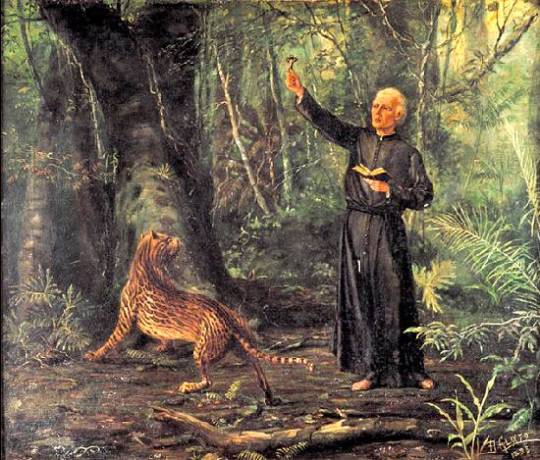
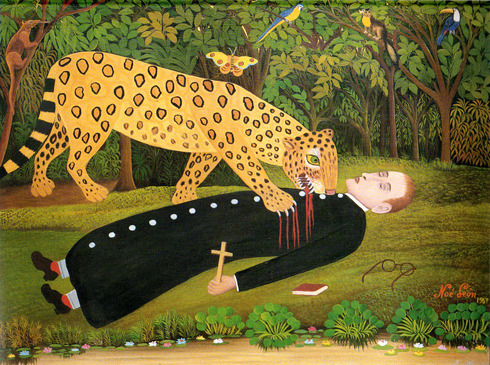

1. Evangelho na Selva (1893), Benedicto Calixto
2. Misionero comido por tigre (1967), Noé León
3. A redenção (2022), Daiara Tukano
#benedito calixto#benedicto calixto#noé león#daiara tukano#a redenção#misionero comido por tigre#jauara ichê#eu jaguar#perspectivismo ameríndio#queue cutie
25 notes
·
View notes
Text
*waves* hello there, how are people doing
#weather is hot and so is regura and daiara and timelias and akam you're welcome#i've been doing fine! some stressful bits that will stay as big background worries for a few months (administration my beloathed)#but also. have finally been doing some pretty stuff with goodies lately (presenting and filing#(CLASSIFYING SO MANY STICKERS. I'M SO HAPPY. tcg boxes and card sleeves for small stickers are the best.)#so yaaaaay lots of feelings about best wishes! and the bwot3 and shigesato and aramano and tma#+ still falling into detco.)#also i have been having pink hair for the last 5w and it LASTS hell yeah#également : mais comment ça japan expo c'est dans trois semaines#mais que mais quoi mais non#tag for random things
15 notes
·
View notes
Text
Visita a Brasília - DF
Dos dias 19 a 22 de outubro estivemos como curso e como turistas no SINFOP, apresentamos trabalho e turistamos um pouco. Confesso que pra mim, a melhor parte foram as visitas e as conversas extra simpósio. E houveram lugres lindos, mas um em especial, não poderia não estar aqui.

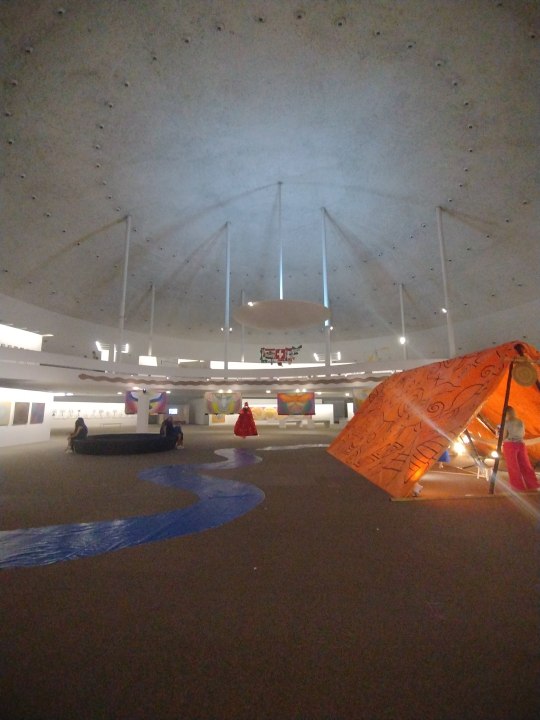
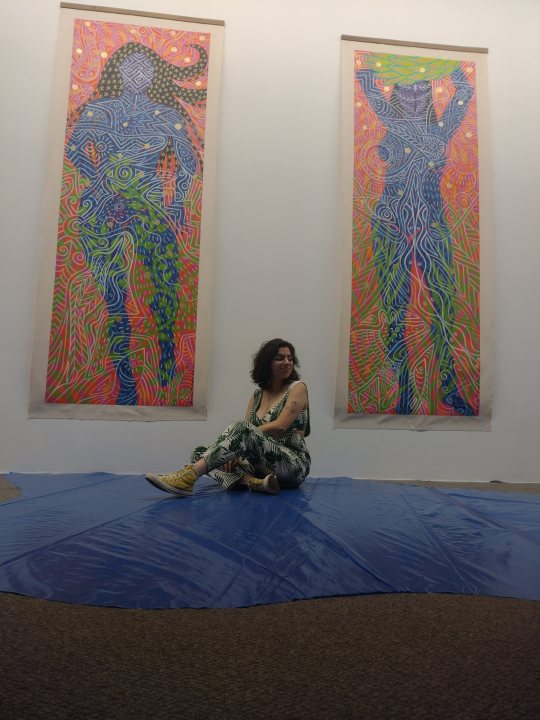




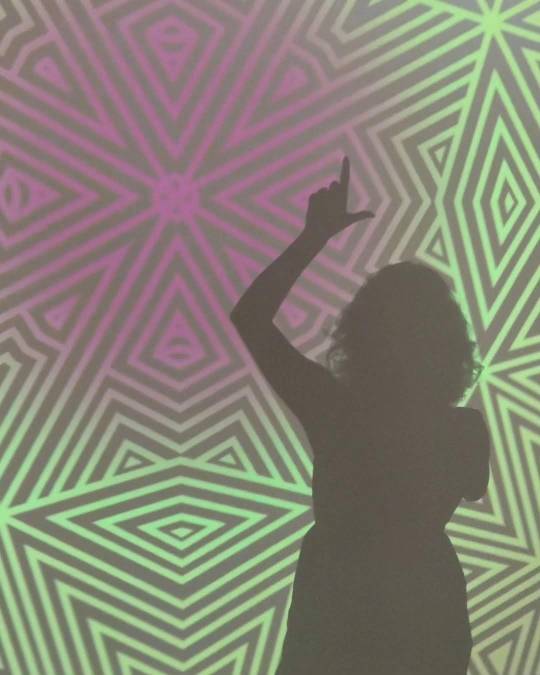
instagram
A Daiara é simplesmente sensacional, eu me vi perdida nas intervenções e nos desenhos, pinturas - e eu esqueci de tirar foto de tanta coisa por causa disso.... - É de tamanha beleza e socos no estômago, é coragem e resistência. Me perdi na sua arte e o tempo foi infinitamente pouco para apreciar o seu olhar do mundo. Não sei transcrever as sensações - o que mostra que ando escrevendo e me expressando pouco -, mas a mulher é sensacional, inteligentíssima e trás, na sutileza e nem só na sutileza, a ligação da mulher com a natureza, com o sagrado, com a vida. Ela é surreal, na verdade ela é muito real, virei fã, obviamente instantaneamente no momento em que pisei em sua exposição.
Foi uma experiência mágica, transcendental, eu não sei, mas fiquei tão impressionada que tirei poucas fotos, pois já tinha a consciência de que nada transportaria o sentimento de estar lá. Foi a coisa mais extraordinária que já vi.
instagram
instagram
#arte#admiração#Daiara Tukano#arte indígena#indígena#indígenas#direitos humanos#feminism#feminismo#Brasil#Instagram
3 notes
·
View notes
Text


Daiara Tukano
Kahtiri Eõrõ (Mirror of life), Bo'éda Hori (Rainbow)
Photos from: http://34.bienal.org.br/artistas/8862
7 notes
·
View notes
Text

Hedgehog
Detail from a forest painting by Daiara Tukano, an indigenous Brazilian artist who created the painting for the exhibition Dear Earth at the Hayward Gallery, London.
#found#art#london#nature#climate emergency#modern art#dear earth#indigenous artist#Brazilian artist#daiara tukano#hedgehog#forest#painting
1 note
·
View note
Text
gatitos!

ig: daiara greice
2 notes
·
View notes
Photo

A artista Dominique de Lapouble compõe pinturas digitais mescladas com fotografias, desenho e colagens e as aproxima das capturas pictóricas do cinema que, usa como recursos as sequências de imagens, o movimento, a luz, o som, o tempo, o imprevisível, o efeito especial inconstante, dentre outros, que conduzem o espectador a perceber o ritmo dos personagens nas telas e o modo pelo qual podem ser transformados em narrativas visuais e poéticas. A temática diversa apresenta seres saídos da floresta, dos rios, dos ventos e da terra, mulheres audazes, registros urbanos que remetem o observador a visão de cidades interdimensionais e seres míticos simbólicos, e exige da artista esmero técnico e conhecimento de tecnologias para produção, reprodução e apropriação de imagens singulares envolvidas a profusão de cores que, contribuem para abrir as cortinas e trazer a público o imaginário ancestral tramado pela Cosmogonia indígena, africana e grega dos tempos imemoriais. As suas criações podem ser visualizadas como partes de encenações teatrais e/ou roteiros do realismo fantástico e buscam, como bem assinala o poeta Manoel de Barros: "Escrever, nem uma coisa Nem outra - A fim de dizer todas - Ou, pelo menos, nenhumas. Assim, Ao poeta faz bem Desexplicar - [...]." Em seu processo criativo fotografa, desenha e produz pinturas digitais, vídeoarte e outros. Na paleta de cores e conteúdos dialoga com Daiara Tukano, Denilson Baniwa, Jader Esbell, Olafur Eliasson, Maotik, Renata Felinto e outros É mineira, vive e trabalha em Belo Horizonte e participou de diversas exposições Individuais e coletivas em Belo Horizonte, Alemanha, Colômbia, Itália, Peru e outras. Todas as obras não tem títulos, as dimensões: variam em 50cm x 50cm 50cm x 60cm, R$ 1.600,00; e 50cm x 70cm, R$ 1.850,00 e todas podem ser impressas em tamanhos maiores no Canvas. @dominiquinha #colecionadoresdearte #comprearte #colecionearte #renatabasquesarquitetura #marchand #colecionadoresbh #cristinamenezesarquitetura #rcavinainteriores #artdealer #pinturadigital #pinturadigitalembh #arqutetosbh #designdeinteriores #decoradoresbh #galerialabyrinthus #artedecolonial #colecionador #colecionismo https://www.instagram.com/p/Cf_1E0ksGyB/?igshid=NGJjMDIxMWI=
#colecionadoresdearte#comprearte#colecionearte#renatabasquesarquitetura#marchand#colecionadoresbh#cristinamenezesarquitetura#rcavinainteriores#artdealer#pinturadigital#pinturadigitalembh#arqutetosbh#designdeinteriores#decoradoresbh#galerialabyrinthus#artedecolonial#colecionador#colecionismo
2 notes
·
View notes
Text
Traveling exhibition Nhe’ẽ Porã: Memory and Transformation – Belém (PA)
Emílio Goeldi Paraense Museum
From February 7th to July 28th, 2024
It proposes a dive into the history, memory and current reality of the languages of the indigenous peoples of Brazil, through ethnographic and archaeological objects, audiovisual installations and works of art. The exhibition seeks to show other points of view on the material and immaterial territories, histories, memories and identities of these people, bringing to light their trajectories of struggle and resistance, as well as the corners and charms of their cultures.
Among the pieces included in the exhibition are several buttons – a type of adornment used to enlarge the lower lip; and tembetás - pieces of quartz placed under the lips. Both are objects that demonstrate skills valued among many people: oratory and listening. Also included in the exhibition was a rare bench carved in quartz, which in the Tukano worldview is directly associated with the grandmother of the universe, Yepário.
For a century and a half, the Museu Paraense Emílio Goeldi has been carrying out research, dissemination and preservation work on the ways of indigenous peoples, among the most recent includes the project Replicando o Passado, in partnership with potters from Icoaraci, district of Belém (PA ).
A product of this project, a replica of a Marajoara funerary urn, originally created by indigenous people who inhabited the Amazon region since approximately the year 500, will also be displayed at the exhibition.
Find out more about the exhibition
“Language is thought, language is spirit, language is a way of seeing the world and appreciating life”. This is how curator Daiara Tukano describes the starting point of Nhe’ẽ Porã: Memory and Transformation. The immersion begins with the name of the exhibition itself, which comes from the Guarani Mbya language: nhe’ẽ means spirit, breath, life, word, speech; and porã means beautiful, good. Together, the two words mean “beautiful words”, “good words” – that is, sacred words that give life to the human experience on earth.
With the participation of around 50 indigenous professionals, the exhibition is co-curated by anthropologist Majoí Gongora; special consultancy from Luciana Storto, a linguist specializing in the study of indigenous languages; in dialogue with the special curator of the Portuguese Language Museum, Isa Grinspum Ferraz.
The exhibition has a circular logic guided by a river of words written in different indigenous languages that crosses the entire exhibition space, connecting the rooms in a continuous cycle. At the beginning of the exhibition, the visitor comes across a forest of indigenous languages representing the great diversity that exists today in Brazil. In this forest, the public will be able to discover the sound of several of them.
The room next door, “Language is Memory”, brings to light histories of contact, violence and conflict resulting from the invasion of indigenous territories from the 16th century to contemporary times, problematizing the colonial process that declares itself “civilizing”. In this environment, other stories will be told through archaeological objects, works by indigenous artists, documentary records, audiovisual resources, multimedia and maps created especially for the exhibition with data on the distribution of the population and indigenous languages across Brazilian territory.
The transformations of indigenous languages are addressed in content that explores the resilience, richness and multiplicity of indigenous peoples' forms of expression. “We put into debate the fact that we are described as unscripted people, without writing, but our paintings are also written – just not alphabetic”, explains Daiara Tukano.
In the third room, the public will learn about the plurality of contemporary indigenous actions and creations, distributed in thematic niches, based on their protagonism in different spaces of society, such as their performance in teaching, research and artistic languages. In the space it is also possible to watch scenes from the Indigenous Peoples March, directed by filmmaker Kamikia Kisédjê.
By following the river's route, visitors reach a fourth nocturnal environment, an introspective dreamlike atmosphere that allows contact with the force present in the songs of masters of beautiful words. The river that ran along the exhibition floor now climbs the wall like a large snake until it turns into clouds of words – preparing the rain that will flow over the river itself again, continuing the cycle.
source: https://www.gov.br/museugoeldi/pt-br/arquivos/noticias/exposicao-nhe2019e-pora-memoria-e-transformacao-chega-ao-museu-goeldi
#edisonmariotti edison mariotti @edisonblog
.br
Exposição itinerante Nhe’ẽ Porã: Memória e Transformação – Belém (PA)
Museu Paraense Emílio Goeldi
De 7 de fevereiro a 28 de julho de 2024
Propõe um mergulho na história, memória e realidade atual das línguas dos povos indígenas do Brasil, através de objetos etnográficos, arqueológicos, instalações audiovisuais e obras de arte. A exposição busca mostrar outros pontos de vista sobre os territórios materiais e imateriais, histórias, memórias e identidades desses povos, trazendo à tona suas trajetórias de luta e resistência, assim como os cantos e encantos de suas culturas.
Entre as peças incorporadas à exposição estão vários botoques – tipo de adorno usado para alargar o lábio inferior; e tembetás - peças de quartzo colocadas sob os lábios. Ambos são objetos que evidenciam habilidades valorizadas entre muitos povos: a oratória e a escuta. Também foi incluído na exposição um raro banco esculpido em quartzo que na cosmovisão tukano está diretamente associado à avó do universo, Yepário.
Há um século e meio que o Museu Paraense Emílio Goeldi desenvolve trabalhos de pesquisa, divulgação e preservação dos modos de fazer dos povos indígenas, dentre os mais recentes inclui o projeto Replicando o Passado, em parceria com ceramistas de Icoaraci, distrito de Belém (PA).
Produto deste projeto, também será exibida na exposição a réplica de uma urna funerária marajoara, elaborada originalmente por indígenas que habitaram a região amazônica desde aproximadamente o ano 500.
Saiba mais sobre a exposição
“Língua é pensamento, língua é espírito, língua é uma forma de ver o mundo e apreciar a vida”. É assim que a curadora Daiara Tukano descreve o ponto de partida de Nhe’ẽ Porã: Memória e Transformação. A imersão começa no próprio nome da mostra, que vem da língua Guarani Mbya: nhe’ẽ significa espírito, sopro, vida, palavra, fala; e porã quer dizer belo, bom. Juntos, os dois vocábulos significam “belas palavras”, “boas palavras” – ou seja, palavras sagradas que dão vida à experiência humana na terra.
Contando com a participação de cerca de 50 profissionais indígenas, a exposição tem co-curadoria da antropóloga Majoí Gongora; consultoria especial de Luciana Storto, linguista especialista no estudo de línguas indígenas; em diálogo com a curadora especial do Museu da Língua Portuguesa, Isa Grinspum Ferraz.
A exposição tem uma lógica circular guiada por um rio de palavras grafadas em diversas línguas indígenas que atravessa todo o espaço expositivo, conectando as salas em um ciclo contínuo. No início da exposição, o visitante se depara com uma floresta de línguas indígenas representando a grande diversidade existente hoje no Brasil. Nessa floresta, o público poderá conhecer a sonoridade de várias delas.
A sala ao lado, “Língua é Memória”, traz à tona históricos de contato, violência e conflito decorrentes da invasão dos territórios indígenas desde o século 16 até a contemporaneidade, problematizando o processo colonial que se autodeclara “civilizatório”. Neste ambiente, outras histórias serão contadas por meio de objetos arqueológicos, obras de artistas indígenas, registros documentais, recursos audiovisuais, multimídia e mapas criados especialmente para a exposição com dados sobre a distribuição da população e das línguas indígenas pelo território brasileiro.
As transformações das línguas indígenas são tratadas em conteúdos que exploram a resiliência, a riqueza e a multiplicidade das formas de expressão dos povos indígenas. “Colocamos em debate o fato de que somos descritos como povos ágrafos, sem escrita, mas nossas pinturas também são escritas – só que não alfabéticas”, explica Daiara Tukano.
Na terceira sala, o público conhecerá a pluralidade das ações e criações indígenas contemporâneas, distribuídas em nichos temáticos, a partir de seu protagonismo em diferentes espaços da sociedade, a exemplo de sua atuação no ensino, na pesquisa e nas linguagens artísticas. No espaço é possível ainda assistir a cenas da Marcha dos Povos Indígenas, sob direção do cineasta Kamikia Kisédjê.
Ao acompanhar o percurso do rio, os visitantes alcançam um quarto ambiente, noturno, uma atmosfera onírica introspectiva que permite o contato com a força presente nos cantos de mestres e mestras das belas palavras. O rio que percorria o chão da exposição, agora sobe a parede como uma grande cobra até se transformar em nuvens de palavras – preparando a chuva que voltará a correr sobre o próprio rio, dando continuidade ao ciclo.
Traveling exhibition Nhe’ẽ Porã: Memory and Transformation – Belém (PA) Emílio Goeldi Paraense Museum From February 7th to July 28th, 2024 It proposes a dive into the history, memory and current reality of the languages of the indigenous peoples of Brazil, through ethnographic and archaeological objects, audiovisual installations and works of art.
The exhibition seeks to show other points of view on the material and immaterial territories, histories, memories and identities of these people, bringing to light their trajectories of struggle and resistance, as well as the corners and charms of their cultures.
Among the pieces included in the exhibition are several buttons – a type of adornment used to enlarge the lower lip; and tembetás - pieces of quartz placed under the lips. Both are objects that demonstrate skills valued among many people: oratory and listening.
Also included in the exhibition was a rare bench carved in quartz, which in the Tukano worldview is directly associated with the grandmother of the universe, Yepário.
For a century and a half, the Museu Paraense Emílio Goeldi has been carrying out research, dissemination and preservation work on the ways of indigenous peoples, among the most recent includes the project Replicando o Passado, in partnership with potters from Icoaraci, district of Belém (PA ).
A product of this project, a replica of a Marajoara funerary urn, originally created by indigenous people who inhabited the Amazon region since approximately the year 500, will also be displayed at the exhibition.
Find out more about the exhibition “Language is thought, language is spirit, language is a way of seeing the world and appreciating life”. This is how curator Daiara Tukano describes the starting point of Nhe’ẽ Porã: Memory and Transformation.
The immersion begins with the name of the exhibition itself, which comes from the Guarani Mbya language: nhe’ẽ means spirit, breath, life, word, speech; and porã means beautiful, good. Together, the two words mean “beautiful words”, “good words” – that is, sacred words that give life to the human experience on earth.
With the participation of around 50 indigenous professionals, the exhibition is co-curated by anthropologist Majoí Gongora; special consultancy from Luciana Storto, a linguist specializing in the study of indigenous languages; in dialogue with the special curator of the Portuguese Language Museum, Isa Grinspum Ferraz. The exhibition has a circular logic guided by a river of words written in different indigenous languages that crosses the entire exhibition space, connecting the rooms in a continuous cycle.
At the beginning of the exhibition, the visitor comes across a forest of indigenous languages representing the great diversity that exists today in Brazil. In this forest, the public will be able to discover the sound of several of them.
The room next door, “Language is Memory”, brings to light histories of contact, violence and conflict resulting from the invasion of indigenous territories from the 16th century to contemporary times, problematizing the colonial process that declares itself “civilizing”.
In this environment, other stories will be told through archaeological objects, works by indigenous artists, documentary records, audiovisual resources, multimedia and maps created especially for the exhibition with data on the distribution of the population and indigenous languages across Brazilian territory.
The transformations of indigenous languages are addressed in content that explores the resilience, richness and multiplicity of indigenous peoples' forms of expression.
“We put into debate the fact that we are described as unscripted people, without writing, but our paintings are also written – just not alphabetic”, explains Daiara Tukano. In the third room, the public will learn about the plurality of contemporary indigenous actions and creations, distributed in thematic niches, based on their protagonism in different spaces of society, such as their performance in teaching, research and artistic languages.
In the space it is also possible to watch scenes from the Indigenous Peoples March, directed by filmmaker Kamikia Kisédjê. By following the river's route, visitors reach a fourth nocturnal environment, an introspective dreamlike atmosphere that allows contact with the force present in the songs of masters of beautiful words.
The river that ran along the exhibition floor now climbs the wall like a large snake until it turns into clouds of words – preparing the rain that will flow over the river itself again, continuing the cycle.

0 notes
Text
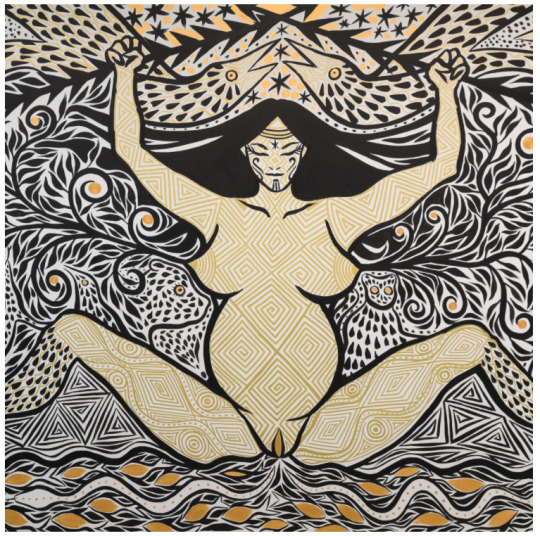
Daiara TUKANO KIHTIMORI: CREATION MEMORIES
In mostra a Roma l’artista e attivista indigena brasiliana Daiara TUKANO
0 notes
Text
Triennale Milano: gli appuntamenti dal 17 al 22 ottobre

Triennale Milano: gli appuntamenti dal 17 al 22 ottobre.
Ecco gli appuntamenti dal 17 al 22 ottobre 2023 della Triennale Milano:
17 ottobre
18.00 Incontro | Il futuro dell’arte indigena: collezioni e mostre
Ingresso libero previa registrazione: triennale.org
Nell’ambito del Public program della mostra Siamo Foresta, curato dal filosofo Emanuele Coccia, Fondation Cartier pour l'art contemporain invita artisti, curatori e intellettuali a discutere del futuro dell’arte indigena, e del modo di collezionarla e rappresentarla nei musei d’arte contemporanea e nelle fondazioni a livello globale. L’incontro vedrà gli interventi di Daiara Tukano, artista, giornalista, attivista per i diritti indigeni, ricercatrice per i diritti umani, e Denilson Baniwa, artista e curatore, presentati da Emanuele Coccia. Interverranno inoltre: Hervé Chandès, Direttore generale artistico, Fondation Cartier pour l'art contemporain; Naine Terena, professoressa, curatrice, educatrice d'arte; Andrea Viliani, Direttore Museo delle Civiltà; Angela Rui, curatrice di design, ricercatrice.
18 ottobre
10.00 Triennale Radio Show
Evento online
Proseguono gli appuntamenti radiofonici in collaborazione con Radio Raheem. Host della trasmissione Damiano Gullì, curatore per Arte contemporanea e Public program di Triennale Milano.
dalle 11.30 alle 13.00 Press preview | Vincenzo Castella. Architetture oblique
Anteprima per la stampa della mostra Vincenzo Castella. Architetture oblique a cura di Lorenza Bravetta, curatrice per Fotografia, cinema e new media di Triennale Milano. La mostra indaga due tematiche care al fotografo: gli orti botanici e le città. I due concetti vengono raccontati attraverso varie scale e dimensioni: dalle fotografie di grande e grandissimo formato a quelle di piccolo formato, fino ad arrivare ai provini a contatto originali. La mostra aprirà al pubblico dal 19 ottobre.
19 ottobre
10.00 Laboratorio | Dance Well - Ricerca e movimento per il Parkinson
Ingresso libero previa iscrizione: triennale.org
Triennale Milano presenta Dance Well: un’iniziativa per promuovere la pratica della danza contemporanea in spazi museali e contesti artistici, che si rivolge principalmente, ma non esclusivamente, a persone che vivono con il Parkinson. Le classi si tengono tutti i giovedì mattina fino alla fine dell'anno. La partecipazione è aperta a tutti.
16.30 Conferenza | Forum rigenerazione urbana
Per maggiori informazioni sul programma della conferenza e per iscrizioni all’evento: triennale.org
Nell'ambito del Forum dell'Assessorato Rigenerazione Urbana del Comune di Milano, una giornata di incontri dedicata alle strategie necessarie per affrontare le sfide del cambiamento climatico e la rigenerazione delle grandi infrastrutture urbane. Gli incontri, organizzati da Milano Urban Center e C40 Cities, approfondiscono i temi con uno sguardo all'ambito internazionale.
18.30 Incontro | Le Convertite
Ingresso libero previa registrazione: triennale.org
Le Convertite è un progetto artistico-laboratoriale realizzato da Marina Ballo Charmet e Walter Niedermayr nella Casa di reclusione femminile nell'isola della Giudecca a Venezia, nel corso del 2022. Ha coinvolto una rete ampia ed eterogenea di soggetti, con l’obiettivo di interrogare il rapporto dell’individuo con l’elemento naturale inteso come antidoto e veicolo di un possibile benessere anche all’interno di uno spazio istituzionale intra-murario come il carcere. Gli artisti Marina Ballo Charmet e Walter Niedermayr discutono del progetto con Antonello Frongia, Gabi Scardi e Stefano Coletto.
20 ottobre
16.00 Incontro | Premio Passione Verde
Ingresso libero previa registrazione: triennale.org
Triennale presenta la premiazione della decima edizione del premio Passione Verde, istituito nel 2012 e promosso dall’Associazione A.Di.P.A. Campania, nell’intento di promuovere la cultura del verde. Il Premio intende attribuire un riconoscimento a chi compie azioni o svolge attività di particolare interesse e valore per il verde pubblico e privato, partendo dalla convinzione che sia necessario offrire un incoraggiamento a tutte quelle persone che si sentono portatrici di “pollice nero” e che perciò rinunciano ad una delle più gratificanti attività umane, utile ai singoli, alle collettività e all’ambiente.
21 ottobre
12.00 Visita guidata | Museo del Design Italiano
Visita guidata a pagamento, per maggiori informazioni: triennale.org
Triennale propone una serie di visite guidate alla scoperta delle sue mostre e della sua collezione permanente. Il Museo del Design Italiano presenta la sua nuova selezione di oggetti e il suo nuovo allestimento attraversando i cento anni della storia di Triennale, con oltre 300 pezzi scelti tra i 1.600 che compongono le collezioni dell’istituzione e altri in prestito da importanti collezioni private.
15.30 e 17.00 Laboratorio | Bamboo Building
Laboratorio a pagamento, per maggiori informazioni: triennale.org
Un'attività che coinvolge famiglie e bambini nella costruzione di strutture e piccoli villaggi in bambù. La tecnica utilizzata, quella della cupola geodetica ideata da Richard Buckminster Fuller e portata da lui in Triennale in occasione della X Esposizione Internazionale nel 1954, permetterà di creare infinite composizioni di piccole abitazioni sostenibili, combinando bastoni di bambù in forme sempre nuove.
18.30 Visita guidata | Siamo Foresta
Visita guidata a pagamento, per maggiori informazioni: triennale.org
Triennale Milano propone delle visite guidate alla scoperta della mostra Siamo Foresta, in collaborazione con Fondation Cartier pour l’art contemporain. L’esposizione approfondisce la visione estetica e politica della foresta come multiverso egualitario di popoli viventi ed esplora l’allegoria di un mondo possibile al di là del nostro antropocentrismo.
22 ottobre
12.00 Visita guidata | Siamo Foresta
Visita guidata a pagamento, per maggiori informazioni: triennale.org
15.30 Laboratorio | Manto di foglie
Laboratorio a pagamento, per maggiori informazioni: triennale.org
Dopo aver esplorato le tante foreste del mondo con una visita guidata alla mostra Siamo Foresta, attraverso il laboratorio Manto di foglie – a cura di Arianna Giorgia Bonazzi e Isabella Musacchia – i bambini saranno chiamati a riconoscere e trovare piante diverse tra le foglie di un coloratissimo tappeto, in una sfida di osservazione e rapidità.
18.30 Visita guidata | Museo del Design Italiano
Visita guidata a pagamento, per maggiori informazioni: triennale.org...
#notizie #news #breakingnews #cronaca #politica #eventi #sport #moda
Read the full article
0 notes
Text
Diretoria Executiva da Amurc é integrada por Mulheres
O presidente da Amurc e prefeito de Coaraci, Jadson Albano empossou a nova diretora executiva, Rita Maria de Souza, a diretora financeira, Itana Barreto e a diretora de projetos, Daiara Santos, para o biênio 2023-2024. A posse acontece em um momento histórico para a instituição, que em 38 anos tem pela primeira vez uma direção executiva coordenada por mulheres.
Com a participação de prefeitos da…
View On WordPress
0 notes
Text
34ª Bienal de São Paulo – Faz escuro mas eu canto
34ª Bienal de São Paulo – Faz escuro mas eu canto
A exposição fica em cartaz até 22 de janeiro de 2023 e foi correalizada junto ao MAR, com o apoio do Instituto Cultural Vale. Não perca: no dia da abertura, a visitação é gratuita! ⚓Você já conhece o trabalho de Daiara Tukano? A artista realizará uma performance na abertura da exposição, ativando sua obra Kahtiri Ēõrõ – Espelho da vida (2020), inspirada nos mantos Tupinambá. A performance tem…

View On WordPress
0 notes
Text
You never give up on me
#audio#music video#music#youtube#v4#original music#daiara#lyrics#ronak#sruthi#murali#you never give up on me#gospel#jesus#god song#lord#keyboard#drums#guitar#singing
3 notes
·
View notes
Text
Araguaína: Deputado pede com urgência reconstrução do DAIARA
Araguaína: Deputado pede com urgência reconstrução do DAIARA
Deputado Estadual Olyntho Neto – Foto: Divulgação
Preocupado com a trafegabilidade dos empresários e moradores próximos ao Distrito Agroindustrial de Araguaína – DAIARA, o deputado Olyntho (PSDB), solicitou na manhã desta terça-feira, 16, com urgência ao governo do Estado, a reconstrução do trecho da TO-422, que liga a BR-153 ao Distrito DAIARA.
O parlamentar vem pedindo essa reconstrução há…
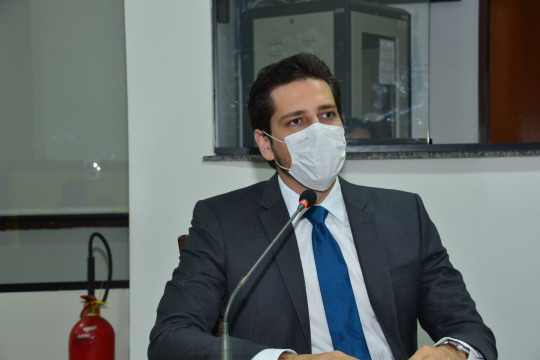
View On WordPress
0 notes
